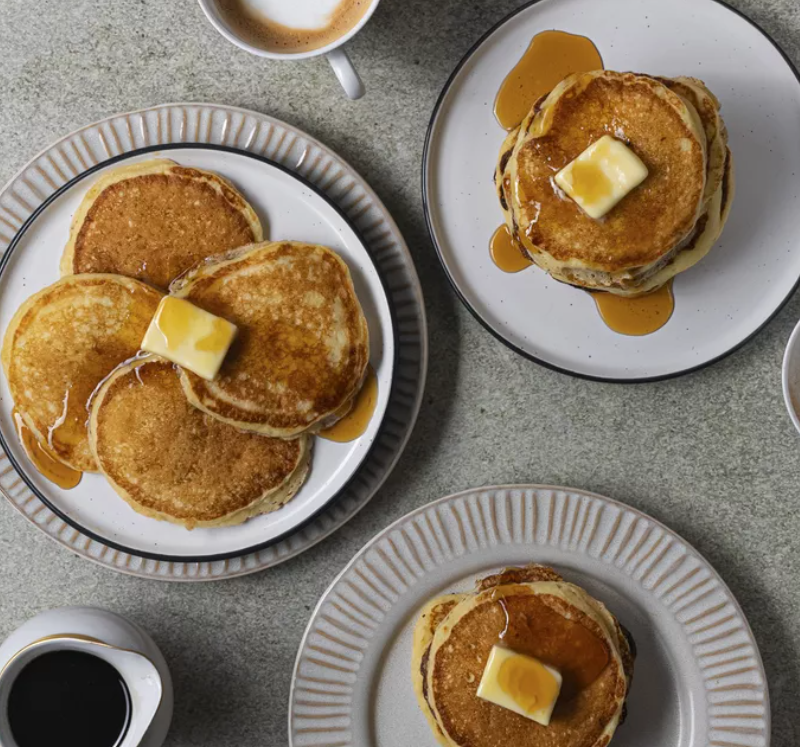
(Image from Serious Eats/Mateja Zvirotic Andrijanic)
This is a food blog made by Emilio Gurany
Buttermilk pancakes are a staple among households, being an easy to make food item that tastes great and is incredibly versatile. In essence, pancakes are a quick rising bread, but a side-effect of the leavening agent, baking soda, is increased Maillard browning. To many, this is a desirable quality, and the amount of baking soda used can correlate to how much browning the pancake undergoes.
More information on the science behind the process can be viewed here
Ingredients
-
Dry Pancake Mix
- For Each Batch of Pancakes
Instructions
-
Dry Pancake Mix
- Combine flour, baking powder, baking soda, salt, and sugar in a medium bowl and whisk until homogenous. Transfer to an airtight container. For Each Batch of Pancakes
- Place one batch of dry mix in a large bowl. In a medium clean bowl, whisk the egg whites until stiff peaks form. In a large bowl, whisk the egg yolks, buttermilk, and sour cream until homogenous. Slowly drizzle in the melted butter while whisking. Carefully fold in the egg whites with a rubber spatula until just combined. Pour the mixture over the dry mix and fold until just combined (there should still be plenty of lumps).
- Heat a large heavy-bottomed nonstick skillet over medium heat for 5 minutes (or use an electric griddle). Add a small amount of butter or oil to the griddle and spread with a paper towel until no visible butter or oil remains. Use a 1⁄4-cup dry measure to place 4 pancakes in the skillet and cook until bubbles start to appear on top and the bottoms are golden brown, about 2 minutes. Carefully flip the pancakes and cook on the second side until golden brown and completely set, about 2 minutes longer. Serve the pancakes immediately, or keep warm on a wire rack set on a rimmed baking sheet in a warm oven while you cook the remaining 3 batches.
Notes
The science behind each ingredient.
All Purpose Flour - The purpose of the flour is to provide a source of gluten formation in the recipe. Gluten is what creates structure in baked goods, and is formed when glutenin and gliadin come into contact and form bonds. This is usually done by adding water to the flour and mixing (6). The gluten formation also traps the carbon dioxide gas released by the leavening agents, giving the pancake its rise (4).
Baking powder - Baking powder was first conceptualized in the mid 1850s by German chemist Eben Horsford. The premise of baking powder is to pre-package the leavening agent of baking soda with an acid it needs to react. This would simplify the baking process and require only a liquid to be added in order to kick start the release of carbon dioxide (1) (3). In this recipe, the baking powder is one of two leavening agents, giving the pancakes their rise (4).
Baking soda - Baking soda, sodium bicarbonate, is an alkaline powder that when combined with an acid and a liquid, will react and release carbon dioxide, which gets trapped in the batter and gives pancakes their rise. The baking soda will not react if there is no acid present, in contrast to baking powder which contains an acid in it (4). The main purpose behind these leavening agents is the release of carbon dioxide, and the same effect can be achieved using dry ice, which is carbon dioxide in its solid state. The phase change to gas creates the same effect, giving bread its rise (2).
Kosher salt - Salt is used to enhance flavors and counteract the sugar.
Sugar - Sugar is used to sweeten the recipe.
Eggs - The purpose of the eggs is to help set the pancakes as they cook, and provide some extra lift (4).
Buttermilk - Apart from flavor, the buttermilk provides the acid necessary for the baking soda to react and release carbon dioxide gas. Given the high alkalinity of the leavening agents used, the acidity of the buttermilk also helps to balance that out (4).
Sour cream - The sour cream is an alternative acid to the buttermilk. The advantages of sour cream are that it is more acidic but less moist than buttermilk, which allows for more acidity in the recipe without watering it down (4).
Unsalted butter - The butter contributes fat to the recipe, which beyond flavor, limits gluten development by coating the flour. This keeps the pancakes more tender and less stiff (4).
References:
(1) ACS Chemistry for Life. https://www.acs.org/content/acs/en/education/whatischemistry/landmarks/bakingpowder.html#development-of-baking-powder. (Accessed April 13, 2022).\
(2) de Graaf, R; Crough, K; Steiner, I; Hudson, R. Dry Ice as an Alternative Leavening Agent for Pancakes to Demonstrate Phase Transitions or Chemical Transformations. J. Chem. Educ. 2022, 99, 3, 1523-1526. DOI: 10.1021/acs.jchemed.1c00896 (Accessed 2022-04-13 from ACS Publications).
(3) JCE Staff. Flat as a Pancake? Exploring Rising in Baked Goods. J. Chem. Educ. 2000, 77, 10, 1264A. DOI: 10.1021/ed077p1264A (Accessed 2022-04-13 from ACS Publications).
(4) Lopez-Alt, J. Serious Eats. https://www.seriouseats.com/light-and-fluffy-pancakes-recipe. (Accessed March 04, 2022).
(5) Potter, J. 310℉/154℃: Maillard Reactions Become Noticeable. In Cooking for Geeks: Real Science, Great Cooks, and Good Food, 2nd ed.; O’Reilly Media Inc., 2016; pp 213-215.
(6) Potter, J. You Must Choose Your Flour, but Choose Wisely. In Cooking for Geeks: Real Science, Great Cooks, and Good Food, 2nd ed.; O’Reilly Media Inc., 2016; pp 246-250.
(7) Tsen, C; Reddy, P; El-Samahy, S; Gehrke, C. Effects of the Maillard Browning Reaction on the Nutritive Value of Breads and Pizza Crusts. The Maillard Reaction in Foods and Nutrition, 1983. DOI: 10.1021/bk-1983-0215.ch019 (Accessed 2022-04-13 from ACS Publications).